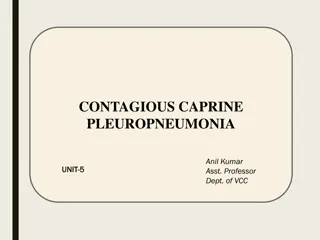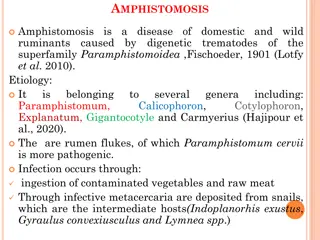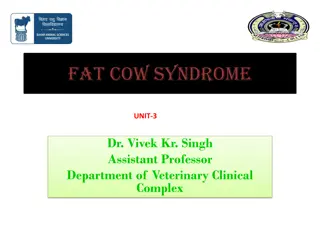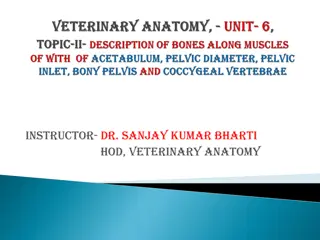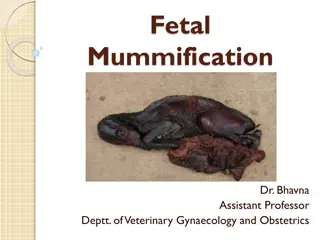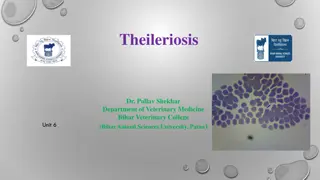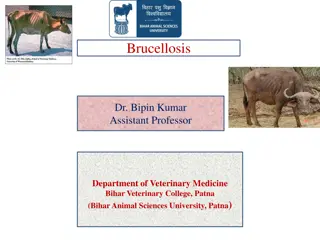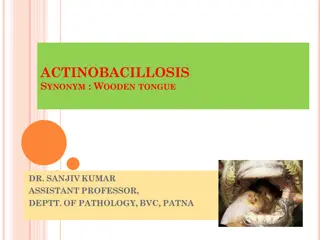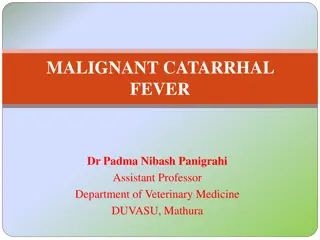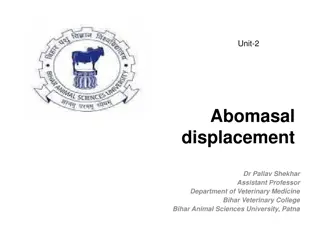Understanding Bluetongue Disease in Sheep, Cattle, and Goats: Causes, Symptoms, and Diagnosis
Bluetongue disease is a viral illness predominantly affecting sheep, with occasional cases in cattle and goats. Transmitted by insect vectors, it can lead to various symptoms such as catarrhal stomatitis, lameness, and reproductive issues. The disease's impact, transmission methods, clinical signs, and diagnostic methods are discussed in detail, shedding light on this significant issue in livestock health.
Download Presentation

Please find below an Image/Link to download the presentation.
The content on the website is provided AS IS for your information and personal use only. It may not be sold, licensed, or shared on other websites without obtaining consent from the author. Download presentation by click this link. If you encounter any issues during the download, it is possible that the publisher has removed the file from their server.
E N D
Presentation Transcript
BLUE TONGUE 8th Semester Dr. Anil Kumar Asst. Professor Dept. of VCC
Bluetongue (catarrhal fever of sheep and sore muzzle) A viral disease of sheep, and occasionally cattle and goats, transmitted by insect vectors. It is characterized by catarrhal stomatitis, rhinitis, enteritis, and lameness. Etiology: Bluetongue virus is an arthropod-borne RNA orbivirus in the Family Reoviridae. Bluetongue is endemic in India The disease has increased manifold in our country in sheep, cattle and buffaloes. BT is most severe in sheep, whereas In cattle, the infection is usually not much noticeable Spread : Bluetongue is transmitted by biting insects of the genus Culicoides.
Mechanical transmission In utero Infection has been transmitted by insemination from an infected bull, since the virus is present in the semen. Pathogenesis: Following infection viral replication initially occur in haematopoietic cells This results in viraemia and subsequent replication in endothelial cells throughout the body Endothelial cells become swollen and later become necrotic, causing oedema, haemorrhage, thrombosis, and infarction Source: Image from Internet
Clinical signs: Bluetongue disease has two different manifestations reproductive problems and vasculitis of several organ systems. A spiked fever often leads to depression, anorexia, and rapid weight loss. Affected animals may develop edema of the lips, tongue, throat, ears, and brisket. Other signs include excessive salivation and hyperemia or cyanosis of the oral mucosa, including the tongue (hence the name bluetongue). Affected sheep often produce profuse serous nasal discharge that soon becomes mucopurulent and produces crusts and excoriations around the nose and muzzle. Oral lesions progress to petechial hemorrhages, erosions, and ulcers. Pulmonary edema is often severe and pneumonia may develop.
stiffness or lameness because of muscular changes and laminitis. Cyanosis or hemorrhagic changes of the skin of the coronet can extend into the horny tissue. A definite ridge in the horn of the hoof may be present for many months after recovery. The reproductive or teratogenic form of the disease varies greatly with strain, host, and environmental factors. Teratogenic effects include abortions, stillbirths, and weak, live dummy lambs. Congenital defects may include hydranencephaly. Diagnosis: clinical signs. Viral isolation from blood obtained during the viremic, febrile state is the most definitive means of diagnosis.
Serologic evaluation, the two types of viral antigen groups called P7 and P2. The former (P7) is found in all bluetongueviruses, and the latter (P2) determines the serotype. complement fixation, agar gel immuno-diffusion (AGID), or one of several ELISA tests. Polymerase chain reaction (PCR-) based tests. Clinicopathologic signs LIKE leukopenia during the early febrile stage of the disease and an increase in serum CK corresponding to the latter phase of muscle stiffness and lameness. Treatment: Broad-spectrum antimicrobials (oxytetracycline 5 mg/kg IM SID to BID) are often used to treat secondary pneumonia and dermatitis. NSAIDs (flunixin meglumine 1.1 to 2 mg/kg IV) may be recommended.
Animals should be kept on soft bedding with good footing. Due to reluctance of animals to eat, they should give a gruel of alfalfa pellets by stomach tube or encouraged to eat soft feeds and green grass. Prevention: Control of Culicoides vector. Modified live vaccines based on local strains and serotypes are available in some parts of the world. The vaccine should be administered at least 2 weeks before breeding season to prevent teratogenic effects. Pregnant animals cannot be vaccinated with modified live vaccines. Sheep that have recovered from an attack of bluetongue are solidly resistant for months to infection by the same viral strain.



